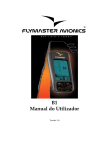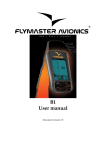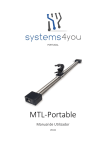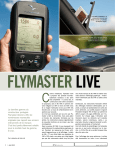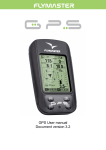Download Flymaster HeartG user manual
Transcript
HEART-G User manual Document version 1.0 2012 FLYMASTER Avionics Ltd. R. de Fundões,nº 151 3700-121 S. João da Madeira Portugal Tel: + 351 256 001 935 Fax: + 351 256 880 551 All rights reserved. Except as expressly provided herein, no part of this manual may be reproduced, copied, transmitted, disseminated, downloaded or stored in any storage medium, for any purpose without the express prior written consent of FLYMASTER Avionics Lda. herein FLYMASTER Avionics. FLYMASTER Avionics hereby grants permission to download a copy of this manual onto a hard drive or other electronic storage medium to be viewed and to print a copy of this manual or of any revision hereto, provided that such electronic or printed copy of this manual must contain the complete text of this copyright notice and provided further that any unauthorized commercial distribution of this manual or any revision hereto is strictly prohibited. Information in this document is subject to change without notice. FLYMASTER Avionics reserves the right to change or improve its products and to make changes in the content without obligation to notify any person or organization of such changes or improvements. Visit the FLYMASTER Avionics website (www.flymaster-avionics.com) for current updates and supplemental information concerning the use and operation of this and other FLYMASTER Avionics products. Document version: 1.0 Page 2 Warning It is the sole responsibility of the pilot to operate the aircraft in a safe manner, maintain full surveillance of all flying conditions at all times, and not become distracted by the Flymaster HEART-G. Flymaster Avionics is not responsible for any damages resulting from incorrect or no data provided by the Flymaster HEART-G. Flight safety is the sole responsibility of the pilot. It is unsafe to operate the Flymaster HEART-G while in the air. Failure by the pilot equipped with a Flymaster HEART-G to pay full attention to the aircraft and flying conditions while flying could result in accident with property damage and/or personal injury. Document version: 1.0 Page 3 Table of contents 1 Introduction........................................................................................................................ 5 2 Getting started....................................................................................................................6 2.1 Switching ON......................................................................................................................... 6 2.2 Switching OFF....................................................................................................................... 7 3 Pairing the HEART-G......................................................................................................... 8 4 Replacing the Battery.........................................................................................................9 5 Calibrating the G Meter.................................................................................................... 10 6 Specifications................................................................................................................... 11 Document version: 1.0 Page 4 1 Introduction Thank you for choosing FLYMASTER HEART-G. If you have any questions or comments regarding the use of our devices you can visit our website or contact our Support Department ([email protected]). The HEART-G is a unique instrument which can be used by active pilots to monitor physical and mental states. The HEART-G measures the heart pulse and 3D accelerations. Collected data is processed and sent via RF interface to the Flymaster instrument range: • Pulse - is the number of heartbeats per minute. • G-Force – Is the sum of the vectors of accelerations exerted on the pilot. G-Force is expressed in multiples of the acceleration of a standard gravity. When no acceleration is exerted the system reports a value of1g (approximately), which corresponds to the gravitational force a sea level, and median latitudes. • Steps – Number of steps detected by the HEART-G since the last reset. By analyzing the accelerations profiles the instrument can detect steps. Each time a step is detected the HEART-G increments a counter. The counter value is sent periodically. The counter is only zeroed when the battery is removed, or when an overflow occurs. Overflow occurs after 32767 steps. • Steps/Min – This value reports the step cadence per minute. Document version: 1.0 Page 5 2 Getting started Using the HEART-G is a very simple, since for the most part everything is automatic. On the back of the HEART-G there are 2 electrodes illustrated in blue on Figure 1 Figure 1 To start using the HEART-G a one time pairing process is required to connect it to your Flymaster instrument. The HEART-G automatically switches on when it detects the human body contact on the electrodes, and automatically switches off after a short period after contact of the body to the electrodes is lost. 2.1 Switching ON Figure 2 Heart-G Position Switching the HEART-G “On” and “Off” is completely automatic. If the battery in the HEART-G is in good condition the HEART-G is switched applying the chest start around the chest so that the electrodes make contact with the skin. For best results, we recommend: • Wear the chest strap against bare skin. • Be sure to moisten the electrodes before exercising. The humidity improves the conductivity and improves pulse detection. Document version: 1.0 Page 6 • The electrodes (one in each tip of the chest strap) should be press firmly against your skin and the Flymaster logo should facing right way up and located in the center of your sternum. (see Figure 2 Heart-G Position). This is important because your heart is not centered but on the left side the HEART-G will not be as efficient in detecting the heart beat if it is with the logo upside down. • Avoid areas with dense chest hair, this will hamper contact of electrodes to the skin. In dry, cold climates, skin dryness will affect the electrode contact so it may take several minutes for the chest belt to function steadily. This is normal and should improve with few minutes of exercise and as the skin begins to sweat. 2.2 Switching OFF To switch off the HEART-G simply remove the chest straps, this will break the contact between the skin and the electrodes, it should switch off in approximately 10 seconds. If the HEART-G is wet it is might not switch off, so to save battery use a towel and dry it. Document version: 1.0 Page 7 3 Pairing the HEART-G Figure 3 RF Probes Screen To get data displayed on your Flymaster instrument the HEART-G needs to be paired with the instrument. Each HEART-G has a preprogramed pairing identity, the following procedure must be carried out to pair the HEART-G with your instrument: • Switch on the HEART-G by putting it against your skin (see section2.1); • Switch on your Flymaster instrument; • Go to Menu->Settings->RF Probes; You should see a list of RF probes (see Figure 3 RF Probes Screen). The list includes all the RF probes previously paired, as well as all the RF probes not paired but that are visible, i.e. transmitting and in range. If the HEART-G is on and working you should see it in the RF Probes list. • Using the UP and DOWN keys to select your HEART-G and press ENTER. • Change the “Paired” parameter to “YES”, and press ENTER to confirm. Now both the HEART-G, and the Flymaster instrument are paired, so you can start use them. This process need only to be done once. ATTENTION - In order to see the HEART-G data on your instrument you should use the Designer to define a Layout with the adequate Data Fields. Document version: 1.0 Page 8 4 Replacing the Battery The HEART-G uses a CR2032 3V battery, which is pre-installed. If the heart rate signals become unsteady or stop your chest belt battery may need replacing. To replace the chest belt battery: • Using a coin, twist the battery cover counter-clockwise until it clicks out of place. • Replace the old battery and close the battery cover by twisting it clockwise until it is r mly in place. Figure – Opening Battery Compartment Document version: 1.0 Page 9 5 Calibrating the G Meter Figure 4 Heart-G calibration As referred previously the HEART-G includes a 3D accelerometer which is used to measure the G-force acceleration acting on the pilot. Due to the gravitational pull of the earth, at rest g-force acceleration on the pilot should be 1g. Should the accelerometer become uncalibrated a different value may be shown, in this case the accelerometer can be re-calibrated by following this procedure: • Remove the battery from the HEART-G • Put the HEART-G on a horizontal position (place it on a horizontal surface) with the battery cover facing up. • Use one hand to touch both HEART-G electrodes and at the same time insert the battery (ensure it is in the horizontal position see Figure 4 Heart-G calibration). • After inserting the battery within a period of 10 seconds, make contact with the electrodes and release 3 times, this will cause the G-Meter to calibrate to 1g. Document version: 1.0 Page 10 6 Specifications Model HEART-G Power Supply 3 VDC (1 lithium battery CR2032) G meter range: 0~16g Steps Number: 32767 Steps/Min Range 0 ~ 1500 Heart Rate HR measuring range: 40-240 bpm (beats per minute) Transmission Range: 1 meter - may decrease with low battery Water Resistant Splash proof G-Meter temperature: Operating Environ- humidity: ment -10°C to 60°C 30 to 85% RH Approx. 120 hours • Specifications are may change without notice. Document version: 1.0 Page 11












